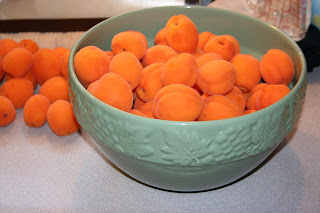 Playing with apricots is so easy because . . . and this is the exciting part . . .there is no peeling of fruit skin. Pull apart the fruit and remove pit. Cut off any parts not acceptable and WA LAH~ ready to start Whipping into a delicious concoction. I LOVE the color of apricots. The jars are full of a bright, cheery and chunky jam to be used as glazes, cookie and bar filling, cake filling and glaze or just on little tea sandwiches. Slightly tart; slightly sweet (according to how much sugar you want to add).
Playing with apricots is so easy because . . . and this is the exciting part . . .there is no peeling of fruit skin. Pull apart the fruit and remove pit. Cut off any parts not acceptable and WA LAH~ ready to start Whipping into a delicious concoction. I LOVE the color of apricots. The jars are full of a bright, cheery and chunky jam to be used as glazes, cookie and bar filling, cake filling and glaze or just on little tea sandwiches. Slightly tart; slightly sweet (according to how much sugar you want to add).
The apricots are fresh off the trees, bought right on an apricot farm in Eastern Washington. 22 pounds for $23.95. Apricots are ripe just before cling-free peaches and pears and I always missed the opportunity to get a box. This year, going blueberry picking coincided with the apricot season sooo I am ecstatic; it is always those little things that tickle me the most!
 I have made chunky apricot preserves and apricot Riesling jam. The recipe below is for the Apricot Riesling Jam; adapted from a recipe I found at SimplyRecipes.com.
I have made chunky apricot preserves and apricot Riesling jam. The recipe below is for the Apricot Riesling Jam; adapted from a recipe I found at SimplyRecipes.com.Apricots naturally break down when cooked. Adding about 1/3 box of pectin powder to my sugar and stirring before adding to the apricots allows me to not cook the mixture as long; meaning chunky preserves and NOT apricot puree.
(The majority of the wine cooks out and leaves a wonderful flavor to the preserves. If you do not want to use wine; leave it out. The apricots provide enough natural juices so you do not have to worry about replacing with another type of liquid.)
 Apricot Riesling Jam
Apricot Riesling Jam6 cups of apricots pulled into two pieces and pits discarded
2 cups of sugar
1/3 box of Sure Jell Fruit Pectin powder; stir into the sugar
1/3 cup of Late Harvest Riesling
5 tablespoons of lemon juice
 Place the apricots, sugar, pectin, wine, and lemon juice in a large (at least 4-qt), thick-bottomed, stainless steel pot and bring to a boil over medium-high heat. Place a couple small plates in the freezer, these will be used to test the jam later.
Place the apricots, sugar, pectin, wine, and lemon juice in a large (at least 4-qt), thick-bottomed, stainless steel pot and bring to a boil over medium-high heat. Place a couple small plates in the freezer, these will be used to test the jam later.The mixture will boil and rise in volume. Skim off the pale yellow foam that forms at the top and discard. The boil will subside to larger bubbles, but still bubble vigorously. Be sure to begin gently stirring the jam frequently to prevent it from sticking to the bottom.
After about 12 to 15 minutes begin testing the jam by placing a small amount on a cold plate. Allow 30 seconds to pass and then run your finger through it to see what the cooled consistency will be. Boil for a few minutes longer if desired for a thicker jam.
Ladle into hot, sterilized canning jars (I sterilize by washing the jars and rings in the dishwasher) and seal leaving 1/4 inch of head space. Before applying the lids, sterilize the lids by placing them in a bowl and pouring boiling water over them. Wipe the rims of the jars clean before applying the lids.
I also put the jars in a hot water bath. Use a canning kettle and fill with enough water to submerge jars with at least 1" of water over the tops of jars. Bring water to a boil. Put jars in the metal jar holder and lower into the water. Bring water back to boiling and boil for 10 minutes. Remove jars and let sit until you hear the cute little popping noise notifying you the jars are sealed.
The next day, you can remove your rings for repeat canning use and display your bright colored, freshly canned apricots for all to see ~ especially you!